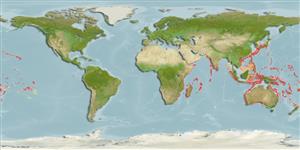Common names from other countries
Environment: milieu / climate zone / depth range / distribution range
Ecología
marino batidemersal; rango de profundidad 150 - 300 m (Ref. 5222). Deep-water; 44°N - 39°S, 29°E - 136°W (Ref. 5222)
Distribución
Países | Áreas FAO | Ecosistemas | Ocurrencias, apariciones | Point map | Introducciones | Faunafri
Indo-West Pacific: Somalia and South Africa to Japan, Australia and New Zealand. Except for Japan, China, and Korea, most distribution records for Epinephelus septemfasciatus are probably based on this species. Reported as Epinephelus compressus by Postel et al. (Ref. 6453).
Tamaño / Peso / Age
Maturity: Lm ? range ? - ? cm
Max length : 130 cm TL macho / no sexado; (Ref. 4787); peso máximo publicado: 80.0 kg (Ref. 4787); edad máxima reportada: 43 años (Ref. 92312)
Espinas dorsales (total) : 11; Radios blandos dorsales (total) : 14 - 15; Espinas anales: 3; Radios blandos anales: 9. Distinguished by the following characteristics: body buff with 8 broad dark brown bars; blackish brown pelvic fins and distal half of the soft dorsal and anal fins; faint dark band from eye to the middle opercle spine; presence of blackish maxillary streak; minute melanophores covering gill rakers and gill arches; depth of body contained 2.2-2.7 times in SL; head length 2.4-2.5 times in SL; distinctly convex interorbital area, convex dorsal head profile; angular preopercle, enlarged serrae at angle; 0-3 small spines at lower edge of preopecle anterior to angle; distinctly serrate lower edge of subopercle and rear edge of interopercle; convex upper edge of operculum; posterior nostrils 2-3 times larger than anterior nostrils; maxilla reaches to below rear half of eye (Ref. 89707).
Probably occurs in rocky reefs. Its apparent rarity may be due to its preference for relatively deep water.
Life cycle and mating behavior
Maturities | Reproducción | Spawnings | Egg(s) | Fecundities | Larva
Craig, M.T. and P.A. Hastings, 2007. A molecular phylogeny of the groupers of the subfamily Epinephelinae (Serranidae) with revised classification of the epinephelini. Ichthyol. Res. 54:1-17. (Ref. 83414)
IUCN Red List Status (Ref. 130435)
CITES (Ref. 128078)
Not Evaluated
Threat to humans
Reports of ciguatera poisoning (Ref. 30302)
Human uses
Pesquerías: escaso valor comercial
Herramientas
Special reports
Download XML
Fuentes de Internet
Estimates based on models
Preferred temperature (Ref.
115969): 13.4 - 21.2, mean 15.7 (based on 136 cells).
Phylogenetic diversity index (Ref.
82804): PD
50 = 0.5001 [Uniqueness, from 0.5 = low to 2.0 = high].
Bayesian length-weight: a=0.01349 (0.00612 - 0.02972), b=3.03 (2.86 - 3.20), in cm Total Length, based on LWR estimates for this Genus-body shape (Ref.
93245).
Nivel trófico (Ref.
69278): 4.0 ±0.7 se; based on size and trophs of closest relatives
Resiliencia (Ref.
120179): Muy bajo, población duplicada en un tiempo mínimo superior a 14 años (Preliminary K or Fecundity.).
Fishing Vulnerability (Ref.
59153): High to very high vulnerability (68 of 100).
